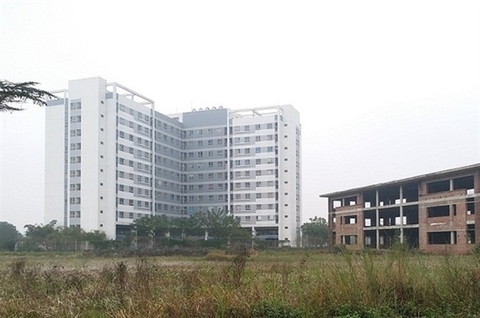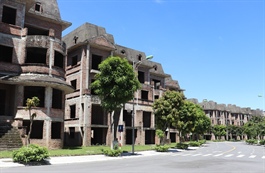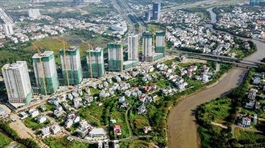Ho Chi Minh City plans better housing for workers
Ho Chi Minh City plans better housing for workers
Ho Chi Minh City is currently making immense efforts to revive manufacturing units once again, as the pandemic conditions begin to ease and life is returning back to a new normal.
Ilustrative photo. |
The City is also looking at providing better housing for migrant workers and laborers, and considering on building 300,000 social houses for low-wage workers within a year in Binh Chanh District, in the Southwest part of the City.
Low cost housing
Ho Chi Minh City has 22 industrial parks and export processing zones (IPs, EPZs), two high-tech parks and the Quang Trung Software City with a total of 420,000 employees. Apart from specialists, managers and workers who have housing in the City and neighboring provinces, the rest of about 300,000 workers live in rental accommodations. This number is similar to the figures released by the Ho Chi Minh City Institute for Development Studies and the Department of Construction. These 22 IPs and EPZs are located in 21 districts of Ho Chi Minh City and Thu Duc City, with ten of the IPs located in District 7 and the suburban districts of Nha Be and Binh Chanh, four in Cu Chi District, five in Thu Duc City, and one in each of the districts of Tan Binh, Binh Tan and District 12.
However, if this housing project scheme is built, the 300,000 houses will be intended mostly for only workers in the Southern part of Ho Chi Minh City, because it is very far and inconvenient for workers from other areas like Cu Chi District and Thu Duc City. Besides, heavy traffic congestion will always be a problem when commuting.
The question is why these houses are not being planned to be built near IPs with a large numbers of workers, such as in Thu Duc City and Cu Chi District. Binh Chanh District may have large chunks of land available, but the poor infrastructure could make it hard to attract people. In Binh Chanh District's Vinh Loc B Commune, where the City is planning to build 300,000 social houses for workers, more than 1,000 apartments meant for resettlement residents have not been used for several years. Other areas like Thu Duc City, Cu Chi District and Hoc Mon District still have unused plots of land where social houses for workers can be built.
Housing management
In other countries in the Southeast region, specialists, managers and office workers at IPs buy houses or apartments on hire purchase basis, while most laborers live in rented houses. Foreign workers in Singapore can rent houses on a three to five-year contract. When the contract expires, they have to return the houses to the housing management authority. In Ho Chi Minh City, industrial workers now pay VND 2 mn to VND 2.5 mn a month for a 14 square meter room for two to four people, and VND 3 mn to VND 3.5 mn a month for a 16 to 18 square meter room with a bathroom attached for a family to live compactly.
Ho Chi Minh City is going to neither provide 300,000 houses for workers for free of charge nor sell them at low prices. Instead, the City will allow workers to rent the houses during the time they work at an IP nearby. When they no longer work at the IP, the housing management authority will take over these houses. The matter is that workers do not earn high wages, so the rent must not be more than 20% of their monthly income. Laborers in Ho Chi Minh City each make an average of VND 6.5 mn a month or they may make VND 10 mn a month if they work overtime.
Funding sources
It is still unclear what sort of social housing scheme plan that Ho Chi Minh City will invest in. Temporary, low cost buildings or prefabricated houses which cost less, have short lifespans, making it easier for the city authorities to change the purpose of land use whenever it is necessary. The City may also go for the construction of high-rise buildings to save land space. If the City uses its budget and accepts losses, everything would be considered fine during the time of construction, but it would not be easy for management and maintenance work purposes.
Singapore can do it because it has an enormous budget for housing, besides there are not many migrant workers there and population management is also excellent. Tenants even receive notification of the house leasing expiry dates, labor contract expiry dates and visa expiry dates.
It is certain that Ho Chi Minh City will not use public budget because it does not have such a big fund amount for such purpose. Therefore, it will call for investments from domestic and international private investors. The government and the City authorities will provide investors with significant incentives like exemption or reduction of land rental, taxes, low-interest loans and legal support. Yet this kind of business can hardly attract big investors, because if they are just simple houses with tin roofs, small private investors in Ho Chi Minh City, Binh Duong and Dong Nai have been involved in such business for last several years.
If the City builds high-rise buildings for monthly rental of a few million Vietnamese dong per apartment, then capital recovery and profit will be hard for investors, because it would cost huge amounts of money to build high-rise buildings. Even the cheapest high-rise building has to meet the minimum requirements set forth by the Ministry of Construction. They must be built of standard materials and must have elevators, fire prevention and control equipment, besides also parking lots and playgrounds.
These requirements could discourage any investors, and the tenants would have to pay extra costs like fire control, social order, environmental protection, security, lighting and standby generators. To prevent the tall buildings from becoming high-rise slums, it is also essential to take into consideration other factors such as recreational facilities, green areas and garbage collection.
One suggestion from experts that Ho Chi Minh City authorities must seriously consider is that factory owners and companies in IPs should make mandatory contributions to housing costs of their workers. It is strange and surprising that not a single provision in the Foreign Investment Code, which was issued in 1987 and has been revised several times, has ever required company owners to build houses for their workers to live in and provide a stable and steady work force to the companies.
























